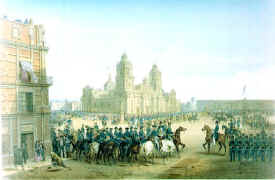The Mexican-American War
| After Texas was annexed, the United States sent John Slidell to Mexico to
settle the heated debate over the exact location of the southern boundary of
Texas. Slidell was instructed to offer the Mexican government $5 million to
accept the Rio Grande as the official border between the two countries. He was
also to offer to buy California. The Mexican government, however, refused to
greet Slidell, and they continued to recognized the Nueces River as the
legitimate border.
In July of 1845, President James Polk sent troops under General Zachary Taylor
to Corpus Christi. It was at the mouth of the Nueces River. In
March of the next year, Taylor moved his force across the river and, in April,
his men stationed themselves in a fort in the area around present-day
Brownsville. Angered by Taylor�s actions, the Mexican government sent their
own soldiers into the region occupied by the American troops. The Battle
at Palo Alto was the first major engagement between the two forces.
|

A lithograph of the Battle Palo Alto by Carl Nebel, 1851
(Courtesy of
the University of Texas at Arlington, Special Collections) |
As a
result, the United States Congress declared war against Mexico on May 13, 1846.
Texans immediately answer the call to fight. Many prominent Texas politicians
resigned their posts to lead Texas volunteer units. One such volunteer was
Governor Henderson. One of the most noted groups fighting in the war was the
famous Texas Rangers. The Rangers proved to be expert scouts, and General Taylor
relied on them often. By March 1847, Taylor had gained control of northern
Mexico. Soon afterwards, American troops arrived by ship in Mexico�s southern
coastal town of Veracruz. The soldiers invading southern Mexico were under the
leadership of General Winfield
Scott. After Scott�s army secured Veracruz,
they moved toward Mexico City.
| The Mexican army could not stop the American soldiers� advance. By
September, the war was virtually over. On February 2, 1848, a treaty ending the
war with Mexico was signed at the little Mexican town of Guadalupe Hidalgo. The
Treaty of Guadalupe Hidalgo required Mexico to recognize that Texas was legally
a part of the United States. Furthermore, the southern and western boundaries of
Texas were set at the Rio Grande. Finally, Mexico also agreed to sell the
Mexican Cession to the United States for $15 million. The cession included lands
in the present-day states of California, Nevada, Utah, Arizona, New Mexico,
Colorado and Wyoming. |

A lithograph of General Scott's entrance in Mexico by Carl Nebel, 1851
(Courtesy of the University of Texas at Arlington, Special Collections) |
The Treaty of Guadalupe Hidalgo created problems between Texans and the
United States government. The people of Texas believed the treaty had recognized
their claim to all lands east of the Rio Grande River. However, the citizen of
Santa Fe and other regions in present-day New Mexico did not want to be a part
of Texas. In desperation, these Westerners turned to the United States
government to settle the boundary issue. The debate over this issue once again
centered on slavery.
Those Americans who opposed the spread of slavery opposed recognizing
Texas� claim to the area east of the Rio Grande, also known as the Santa Fe
Territory. Those who favored the spread of slavery were ready to give Texas
authority over the disputed territory. This issue was settled in the halls of
Congress. The final agreement, the Compromise of
1850, allowed California to
enter the Union as a free state; divided the western lands into two territories,
the Utah Territory and New Mexico Territory; ended the slave trade in Washington
D.C.; and gave Texas $10 million dollars in exchange for giving up its land
claims in New Mexico. Texas willingly accepted this agreement because it needed
the money to pay off its outstanding debts.

Additional Resources
Study Guide Questions:
- Why was John Slidell sent to Mexico?
- Why did the United States declare war on Mexico in
May 1846?(7.4:A)
- What requirements for Mexico's surrender were established under the Treaty
of Guadalupe Hidalgo?(7.4:A)
- What problems did the Treaty
of Guadalupe Hidalgo cause between Texas and the United States government?(7.4:A)
- What was the Compromise of 1850?(7.4:A)
Back to Top
|